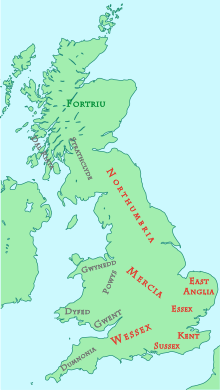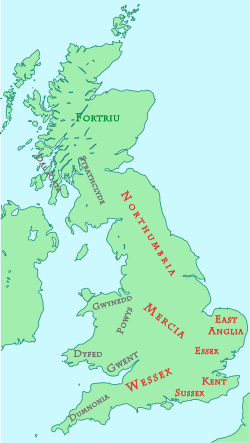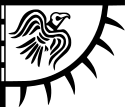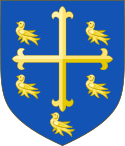Sedm anglosaských království
Sedm anglosaských království
| |||||||||
Geografie
| |||||||||
různé | |||||||||
| Obyvatelstvo | |||||||||
| Státní útvar | |||||||||
drobné dědičné monarchie | |||||||||
| Státní útvary a území | |||||||||
| |||||||||
Sedm anglosaských království nebo Heptarchie je pojem používaný pro označení raně středověkých anglosaských království na jihu, východě a v centru Británie na konci starověku a na počátku středověku do sjednocení Anglie (Skotsko a Wales byly v té době také rozděleny na několik království). První použití tohoto termínu spadá do období 12. století. Označuje přibližně období od roku 500 do roku 850, tedy dobu následující po odchodu římských legií až do sjednocení Anglie králem Ethelstanem. Pojem heptarchie odkazuje na existenci sedmi království, která byla základem sjednoceného anglického království:
Seznam anglosaských království
 Wessex – tj. království Západních Sasů
Wessex – tj. království Západních Sasů- Sussex – tj. království Jižních Sasů
- Northumbrie
- Mercie
- Essex – tj. království Východních Sasů
- Východní Anglie (anglicky East Anglia) – tj. království Východních Anglů
- Kent
Ostatní anglosaská království neřadící se k heptarchii:
- Hwicce
- Lindsey – drobné anglosaské království
Rozsah
V různých etapách tohoto období jednotliví vládcové Northumbrie, Mercie a Wessexu ovládli větší část Anglie a mohou se tak považovat za významnější, ale i v těchto případech se dá hovořit o jednotlivých oddělených královstvích. Poslední výzkumy ukazují, že některá tato království (například Essex a Sussex) svým významem nedosahovala důležitosti ostatních. Vedle těchto sedmi království dále existovalo několik dalších důležitých politických center, jejichž vliv byl srovnatelný s některými se sedmi království. Jednalo se o království (nebo jejich části) – Bernicie a Deira v Northumbrii, Lindsey v oblasti současného hrabství Lincolnshire, Hwicce na jihozápadě Midlands, Magonsete v Mercii, Whitwara na ostrově Wight, Střední Anglie – skupina kmenů usídlených v okolí současného hrabství Leicestershire, Hestingas v okolí Hastingsu a Gewisse v současném hrabství Hampshire.[pozn. 1]
Konec sedmi království

Konec koexistence sedmi království byl postupným procesem. Nájezdy vikingů v 9. století vedly k vytvoření jimi kontrolované oblasti v okolí Yorku a později k rozšíření jejich panství na území označované jako Danelaw (území, kde platily dánské zákony – oblast ve středu a na východě Anglie). Potřeba sjednocení proti společnému nepříteli vedly k tomu, že wessexský král Alfréd Veliký bojoval proti Dánům v 9. století jako vůdce Anglosasů. Jeho následníci ve Wessexu (hlavně Æthelstan) posilovali sjednocený anglosaský stát, až se původní rozdělení na jednotlivá království stalo nevýznamné.
Sedm království v pozdější heraldice
Ve 13. století přisoudili angličtí heraldikové anglosaským královstvím fiktivní erby, některé na základě chabého popisu, například v díle Církevní dějiny národa Anglů je zmínka o zlato-purpurové zástavě vyvěšené nad hrobem Oswalda Northumbrijského, dle níž byl vytvořen pruhovaný erb.
- erby:
Poznámky
- ↑ Český pojem „král“ a „království“ je pozdější konstrukcí, která nahradila předešlé pojmy „kníže“ a „knížectví“, které hierarchicky poklesly a které nelze v raném středověku od „krále“ fakticky odlišit. Slovo „kníže“ je ze stejného germánského zdroje (*kuning), jako anglické king a německé könig, které si ovšem zachovaly význam „král“, tj. vládce země.
Reference
V tomto článku byl použit překlad textu z článku Heptarchy na anglické Wikipedii.
Média použitá na této stránce
The labarum is a symbol that shows the first two Greek letters of the word Christ (ΧΡΙΣΤΟΣ or Χριστός) - Chi (χ) and Rho (ρ).
Autor: Lobsterthermidor (diskuse) 17:29, 3 November 2021 (UTC), Licence: CC BY-SA 3.0
Attributed arms of the Kingdom of Mercia in the Anglo-Saxon Heptarchy: Azure, a saltire or. The earliest surviving recorded use of these attributed arms is in a manuscript dating from the reign of King Henry III (1216-1272), namely College of Arms Ms. L.14. (Source: Wikipedia article w:Mercia). The arms were subsequently used by the Abbey of St Albans, founded by King Offa of Mercia. Following the Dissolution of the Monasteries in the 16th century and the incorporation of the Borough (town) of St Albans the coat of arms was used on the town's corporate seal and was officially recorded as the arms of the town at the Heraldic Visitation of 1634. (Source: wikipedia, quoting "Civic heraldry of England and Wales, www.civicheraldry.co.uk , http://www.civicheraldry.co.uk/herts.html ) The attributed arms are today flown on a standard over Tamworth Castle, in Staffordshire, the ancient seat of the Mercian Kings and appears on street signs welcoming people to the town of Tamworth, styled "the ancient capital of Mercia". It was also flown outside Birmingham Council House during 2009 while the Staffordshire Hoard was on display in the city before being taken to the British Museum in London. The saltire has been incorporated into several coats of arms of Mercian towns, including Tamworth and Leek, both in Staffordshire and Blaby. It was recognised as the Mercian flag by the Flag Institute in 2014. ( https://www.flaginstitute.org/wp/flags/mercia/ )
Autor: AlexD, Licence: CC BY-SA 3.0
Flag of the Welsh Kingdom of Powys and the House of Mathrafal.
Autor: Lobsterthermidor (diskuse) 12:45, 3 November 2021 (UTC), Licence: CC BY-SA 3.0
Autor: Lobsterthermidor (diskuse) 23:35, 3 November 2021 (UTC), Licence: CC BY-SA 3.0
Attributed arms of the Kingdom of Northumbria of the Anglo-Saxon Heptarchy: Paly of eight or and gules. Bede in his Historia Ecclesiastica Gentis Anglorum described the banner on the tomb of the seventh century King Oswald, who had united Bernicia & Deira to form the Kingdom of Northumbria: "they hung up over the monument his banner made of gold and purple". It is by tradition shown gold and red. From: http://www.civicheraldry.co.uk/north_east.html "arms attributed by the medieval heralds to the ancient Kingdom of Bernicia - Paly of eight gold and gules. Bernicia formed the northern part of the present County and its arms may have been suggested by the Venerable Bede's reference to 'a banner made of gold and purple' which was hung over the tomb of St. Oswald, the first Christian King of Northumbria." From wikipedia w:Northumbria "Oswald was a King of Bernicia, who regained the kingdom of Deira after defeating Cadwallon in 634. Oswald then ruled Northumbria until his death in 642. A devout Christian, Oswald worked tirelessly to spread the religion in his traditionally pagan lands. It was during his reign that the monastery at Lindisfarne was created. Oswald fell in the Battle of Maserfield against Penda of Mercia in 642 but his influence endured because, like Edwin, Oswald was venerated as a saint after his death"
Autor: Government of Scotland, according to Lyon King of Arms Act 1672
(Vector graphics image by Eyrian), Licence: CC BY-SA 3.0
The Royal Banner of Scotland, also known as the "Lion Rampant", is the banner of the old arms of the King of Scots. It consists of a lion contained within a "tressure flory counter-flory" (In heraldic terminology, it is blazoned as Or, a lion rampant Gules armed and langued Azure within a double tressure flory counter-flory Gules
- English Royal Banner: Royal Banner of England.svg
The Golden Wyvern, associated with the House of Wessex.
Autor: Jorellaf, Licence: CC BY-SA 4.0
Banner with the traditional arms of the House of Aberffraw, rulers of the Kingdom of Gwynedd, attributed to Llywelyn the Great (d. 1240). Recorded in the Chronica Majora (c. 1250).
Autor: 121.92.79.135, Licence: CC BY-SA 3.0
Flag of Wessex re-done in SVG format 2D representation of work existing pre-20th century / public domain
Attributed arms of the Kingdom of Essex (the "East Saxons") in the Anglo-Saxon w:Heptarchy: Gules, three seaxes barwise in pale argent blades uppermost pommelled and hilted or. In 1932 adopted as the arms of Essex County Council. Text from https://london.wikia.org/wiki/Coat_of_Arms_of_Middlesex_County_Council :
- Coats of arms were invented in the Middle Ages for the Kingdoms of the Anglo-Saxon Heptarchy. That assigned to the Kingdom of the Middle and East Saxons depicted three "seaxes" or short notched swords on a red background. The seaxe was a weapon carried by Anglo-Saxon warriors, and the term "Saxon" may be derived from the word. These arms became associated with the two counties that approximated to the kingdom: Middlesex and Essex. County authorities, militia and volunteer regiments associated with both counties used the attributed arms. In 1910 it was noted that the county councils of Essex and Middlesex and the Sheriff's Office of the County of London were all using the same arms. Middlesex County Council decided to apply for a formal grant of arms from the College of Arms, with the addition of an heraldic "difference" to the attributed arms. Colonel Otley Parry, a Justice of the Peace for Middlesex and author of a book on military badges, was asked to devise an addition to the shield. The chosen addition was a "Saxon Crown", derived from the portrait of King Athelstan on a silver penny of his reign, stated to be the earliest form of crown associated with any English sovereign. The grant of arms was made by letters patent dated 7 November 1910. The undifferenced arms of the Kingdom were eventually granted to Essex County Council in 1932
Further reading:
- "Armorial bearings of Middlesex", The Times. London. 7 November 1910.
- The Book of Public Arms, A.C. Fox-Davies, 2nd edition, London, 1915
- Civic Heraldry of England and Wales, W.C. Scott-Giles, 2nd edition, London, 1953
- C W Scott-Giles, Royal and Kindred Emblems, Civic Heraldry of England and Wales, 2nd edition, London, 1953, p.11
This map shows kingdoms in the island of Great Britain at about the year 800. The colors indicate ethnic groups:
- WESSEX: Anglo-Saxons (red)
- GWYNEDD: Celts (grey)
- FORTRIU: Picts (green).
Autor: Skydrake, Licence: CC BY-SA 3.0
The raven banner according to the Amlaib Cuaran's coin.
Autor: Sodacan, Licence: CC BY-SA 3.0
Attributed royal Coat of arms of King Edward the Confessor (who lived before standardized coats of arms came into use) by Matthew Paris, based on a design on Edward's coinage. Edward's arms were impaled or quartered by his descendants. Blazon: Azure a cross flory between five martlets Or.























